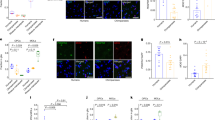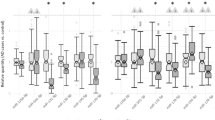Abstract
We used massively parallel sequencing to compare the microRNA (miRNA) content of human and chimpanzee brains, and we identified 447 new miRNA genes. Many of the new miRNAs are not conserved beyond primates, indicating their recent origin, and some miRNAs seem species specific, whereas others are expanded in one species through duplication events. These data suggest that evolution of miRNAs is an ongoing process and that along with ancient, highly conserved miRNAs, there are a number of emerging miRNAs.
This is a preview of subscription content, access via your institution
Access options
Subscribe to this journal
Receive 12 print issues and online access
$209.00 per year
only $17.42 per issue
Buy this article
- Purchase on Springer Link
- Instant access to full article PDF
Prices may be subject to local taxes which are calculated during checkout


Similar content being viewed by others
References
Bartel, D.P. Cell 116, 281–297 (2004).
Alvarez-Garcia, I. & Miska, E.A. Development 132, 4653–4662 (2005).
Griffiths-Jones, S., Grocock, R.J., van Dongen, S., Bateman, A. & Enright, A.J. Nucleic Acids Res. 34, D140–D144 (2006).
Bentwich, I. et al. Nat. Genet. 37, 766–770 (2005).
Berezikov, E. et al. Cell 120, 21–24 (2005).
Margulies, M. et al. Nature 437, 376–380 (2005).
Vagin, V.V. et al. Science 313, 320–324 (2006).
Stein, A.J., Fuchs, G., Fu, C., Wolin, S.L. & Reinisch, K.M. Cell 121, 529–537 (2005).
Bonnet, E., Wuyts, J., Rouze, P. & Van de Peer, Y. Bioinformatics 20, 2911–2917 (2004).
Aravin, A. & Tuschl, T. FEBS Lett. 579, 5830–5840 (2005).
Allen, E. et al. Nat. Genet. 36, 1282–1290 (2004).
Enard, W. et al. Science 296, 340–343 (2002).
Schratt, G.M. et al.Nature 439, 283–289 (2006).
Ashraf, S.I., McLoon, A.L., Sclarsic, S.M. & Kunes, S. Cell 124, 191–205 (2006).
Muotri, A.R. & Gage, F.H. Nature 441, 1087–1093 (2006).
Acknowledgements
We thank the various genome sequencing consortia (see Supplementary Methods for full references) for sharing sequence information through Ensembl (http://www.ensembl.org) before publication and thank C. Reijmer (Vrelinghuis, Medical Center Biltstraat, Utrecht) for providing tissue material. This work was supported by grants from the Horizon (E.B.) and BioRange (E.C.) programs of the Netherlands Genomics Initiative, and a TOP grant (R.H.A.P.) from the Netherlands Organization for Scientific Research.
Author information
Authors and Affiliations
Contributions
This study was designed by R.H.A.P., E.C. and E.B.; L.W.L. prepared human tissues; I.K. and R.B. prepared chimpanzee tissues; F.T. generated libraries; E.B. performed the analysis and wrote a first draft of the paper; E.B., E.C. and R.H.A.P. wrote the paper and I.K., R.B. and F.T. contributed critical comments on the manuscript.
Corresponding author
Ethics declarations
Competing interests
F.T. is founder and Chief Executive Officer of Vertis Biotechnologie AG. Publication of this work may result in an increase in the level of awareness of its services for cloning and analysis of microRNAs.
E.B., E.C. and R.P. are the inventors on a patent application that includes novel miRNA sequences described in this manuscript. This publication may affect the value of this patent.
Supplementary information
Supplementary Fig. 1
Distribution of read densities across the chimpanzee genome. (PDF 140 kb)
Supplementary Table 1
Strand distribution for repeat-derived reads. (PDF 84 kb)
Supplementary Table 2
Sequences of novel human and chimpanzee miRNAs. (PDF 279 kb)
Supplementary Table 3
miRNA families containing novel miRNAs (PDF 64 kb)
Supplementary Table 4
Clusters containing novel human and chimpanzee miRNAs. (PDF 139 kb)
Supplementary Table 5
miRNAs duplicated in human or chimpanzee genomes. (PDF 99 kb)
Rights and permissions
About this article
Cite this article
Berezikov, E., Thuemmler, F., van Laake, L. et al. Diversity of microRNAs in human and chimpanzee brain. Nat Genet 38, 1375–1377 (2006). https://doi.org/10.1038/ng1914
Received:
Accepted:
Published:
Issue Date:
DOI: https://doi.org/10.1038/ng1914
This article is cited by
-
Discovery of the major 15–30 nt mammalian small RNAs, their biogenesis and function
Nature Communications (2023)
-
A comparative analysis of heart microRNAs in vertebrates brings novel insights into the evolution of genetic regulatory networks
BMC Genomics (2021)
-
RNA landscape of the emerging cancer-associated microbe Fusobacterium nucleatum
Nature Microbiology (2021)
-
Comparison of multi-lineage differentiation of hiPSCs reveals novel miRNAs that regulate lineage specification
Scientific Reports (2018)
-
Genome-wide microRNA screening in Nile tilapia reveals pervasive isomiRs’ transcription, sex-biased arm switching and increasing complexity of expression throughout development
Scientific Reports (2018)



